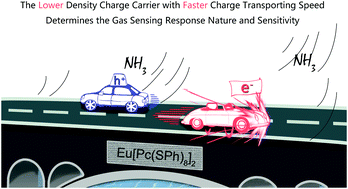当前位置:
X-MOL 学术
›
Mater. Chem. Front.
›
论文详情
Our official English website, www.x-mol.net, welcomes your feedback! (Note: you will need to create a separate account there.)
The lower rather than higher density charge carrier determines the NH3-sensing nature and sensitivity of ambipolar organic semiconductors†
Materials Chemistry Frontiers ( IF 7 ) Pub Date : 2018-02-27 00:00:00 , DOI: 10.1039/c7qm00607a Yanli Chen 1, 2, 3 , Xia Kong 1, 2, 3 , Guifen Lu 3, 4, 5 , Dongdong Qi 3, 6, 7 , Yanling Wu 1, 2, 3 , Xiyou Li 1, 2, 3 , Marcel Bouvet 8, 9, 10 , Daofeng Sun 1, 2, 3 , Jianzhuang Jiang 1, 2, 3, 6, 7
Materials Chemistry Frontiers ( IF 7 ) Pub Date : 2018-02-27 00:00:00 , DOI: 10.1039/c7qm00607a Yanli Chen 1, 2, 3 , Xia Kong 1, 2, 3 , Guifen Lu 3, 4, 5 , Dongdong Qi 3, 6, 7 , Yanling Wu 1, 2, 3 , Xiyou Li 1, 2, 3 , Marcel Bouvet 8, 9, 10 , Daofeng Sun 1, 2, 3 , Jianzhuang Jiang 1, 2, 3, 6, 7
Affiliation

|
Despite the extensive studies and great application potentials, the sensing nature of ambipolar organic semiconductor gas sensors still remains unclarified, unlike their inorganic counterparts. Herein, different numbers of thiophenoxy groups are introduced into the phthalocyanine periphery of bis(phthalocyaninato) rare earth semiconductors to continuously tune their HOMO and LUMO energies, resulting in the ambipolar M[Pc(SPh)8]2 [M = Eu (1), Ho (2)] and p-type M(Pc)[Pc(SPh)8] [M = Eu (3), Ho (4)]. An OFET in combination with direct I–V measurements over the devices from the self-assembled nanostructures of 1–4 revealed the original electron and hole densities (ne and nh) of 3.6 × 1015 and 3.6 × 1018 cm−3 for ambipolar 1, 9.8 × 1016 and 6.0 × 1020 cm−3 for ambipolar 2, and the original hole density (nh) of 2.8 × 1017 and 2.4 × 1017 cm−3 for 3 and 4, respectively. The comparative studies on the sensing behavior of the self-assembled nanostructures of 1–4 revealed that, towards reducing gas NH3, the ambipolar 1 and 2 show an n-type sensing behavior, with the response nature determined by the lower ne rather than higher nh. Meanwhile, the NH3 sensor from 1 with much lower ne than 2 displays higher sensitivity. Nevertheless, also towards NH3, 3 and 4 exhibit a p-type response, with the lower carrier density device 4 showing higher sensitivity. Consequently, the originally lower density carrier (hole vs. electron) with a faster charge transporting speed in the ambipolar semiconducting layer determines not only the gas sensing response nature but also the sensitivity. This is also true for the p-type organic semiconductor in terms of the gas sensing sensitivity.
中文翻译:

较低而不是较高的电荷载流子决定了双极性有机半导体对NH 3的感应性质和灵敏度†
尽管已进行了广泛的研究和巨大的应用潜力,但与无机同类传感器不同,双极性有机半导体气体传感器的传感性质仍不清楚。在此,将不同数量的硫代苯氧基引入双(邻苯二甲酸氰基)稀土半导体的酞菁外围,以连续调节其HOMO和LUMO能量,从而产生双极性M [Pc(SPh)8 ] 2 [M = Eu(1) ,Ho(2)]和p型M(Pc)[Pc(SPh)8 ] [M = Eu(3),Ho(4)]。与直接I – V相结合的OFET从以上的自组装纳米结构的器件的测量1-4揭示了原始电子和空穴密度(Ñ Ë和Ñ ħ的3.6×10)15和3.6×10 18厘米-3为双极1,9.8×10 16和对于双极性2为6.0×10 20 cm -3,对于3和4为2.8×10 17和2.4×10 17 cm -3的原始孔密度(n h), 分别。上的自组装纳米结构的感测的行为比较研究1-4表明,在减少气体NH 3,双极1和2示出了n型感测的行为,与响应性质由下确定Ñ Ë而比高于n h。同时,NH 3从传感器1具有低得多的Ñ ë比2只显示更高的灵敏度。尽管如此,还向NH 3,3和4较低的载流子密度器件4显示出较高的灵敏度,因此显示出p型响应。因此,双极性半导体层中具有较快电荷传输速度的本来较低密度的载流子(空穴相对于电子)不仅决定了气体传感响应的性质,而且还决定了灵敏度。就气体感测灵敏度而言,对于p型有机半导体也是如此。
更新日期:2018-02-27
中文翻译:

较低而不是较高的电荷载流子决定了双极性有机半导体对NH 3的感应性质和灵敏度†
尽管已进行了广泛的研究和巨大的应用潜力,但与无机同类传感器不同,双极性有机半导体气体传感器的传感性质仍不清楚。在此,将不同数量的硫代苯氧基引入双(邻苯二甲酸氰基)稀土半导体的酞菁外围,以连续调节其HOMO和LUMO能量,从而产生双极性M [Pc(SPh)8 ] 2 [M = Eu(1) ,Ho(2)]和p型M(Pc)[Pc(SPh)8 ] [M = Eu(3),Ho(4)]。与直接I – V相结合的OFET从以上的自组装纳米结构的器件的测量1-4揭示了原始电子和空穴密度(Ñ Ë和Ñ ħ的3.6×10)15和3.6×10 18厘米-3为双极1,9.8×10 16和对于双极性2为6.0×10 20 cm -3,对于3和4为2.8×10 17和2.4×10 17 cm -3的原始孔密度(n h), 分别。上的自组装纳米结构的感测的行为比较研究1-4表明,在减少气体NH 3,双极1和2示出了n型感测的行为,与响应性质由下确定Ñ Ë而比高于n h。同时,NH 3从传感器1具有低得多的Ñ ë比2只显示更高的灵敏度。尽管如此,还向NH 3,3和4较低的载流子密度器件4显示出较高的灵敏度,因此显示出p型响应。因此,双极性半导体层中具有较快电荷传输速度的本来较低密度的载流子(空穴相对于电子)不仅决定了气体传感响应的性质,而且还决定了灵敏度。就气体感测灵敏度而言,对于p型有机半导体也是如此。



























 京公网安备 11010802027423号
京公网安备 11010802027423号